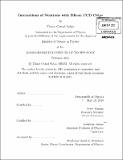Interactions of neutrons with silicon CCD chips
Author(s)
Sahin, Timur Cemal
DownloadFull printable version (4.242Mb)
Alternative title
Interactions of neutrons with silicon charge coupled device chips
Other Contributors
Massachusetts Institute of Technology. Dept. of Physics.
Advisor
Denis Dujmic and Gabriella Sciolla.
Terms of use
Metadata
Show full item recordAbstract
Dark matter makes up approximately 22% of the energy density of the universe and as much as 83% of its matter composition. Despite its ubiquitous nature, it remains incredibly difficult to detect due to the weakness of its interaction with the regular matter. The Dark Matter Time Projection Chamber (DMTPC) is an experiment that searches for traces of ionization created by Weakly Interacting Massive Particles (WIMP's). The detector uses a charge coupled device (CCD) camera to image the ionization signal created in the detector gas. The CCD chip itself is also sensitive to interactions with the WIMP's and the background radiation. In this thesis I explore the contributions these interactions may have on the DMTPC experiment. First, I develop an algorithm that filters out the electronic noise in the CCD chip such that the remaining images contain true ionization events in the chip. Second, I study insidious effects of neutron interaction with the CCD chip. I develop a GEANT4 based Monte Carlo simulation and set up an experiment that uses a neutron source with a known energy and measure the energy deposition in the chip. The energy spectrum agrees with the prediction based on the elastic scattering kinematics and the silicon ionization rate thus providing an energy calibration. Finally, I measure the level of background in the CCD chip coming from the inside of the camera, I set up an experiment in which outside neutrons are shielded with layers of plastic material and x-rays are suppressed with lead bricks surrounding the camera. Cosmic muons create particle showers that can also interact with the CCD chip so I build an active shield using a pair of scintillating paddles. I find that background interactions with silicon produce CCD signals that are small enough to be eliminated by existing DMTPC cuts on interaction range.
Description
Thesis (S.B.)--Massachusetts Institute of Technology, Dept. of Physics, 2011. Cataloged from PDF version of thesis. Includes bibliographical references (p. 43).
Date issued
2011Department
Massachusetts Institute of Technology. Department of PhysicsPublisher
Massachusetts Institute of Technology
Keywords
Physics.